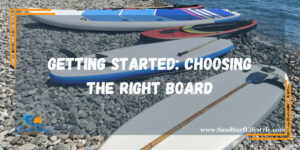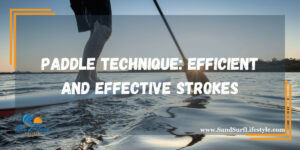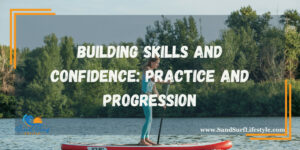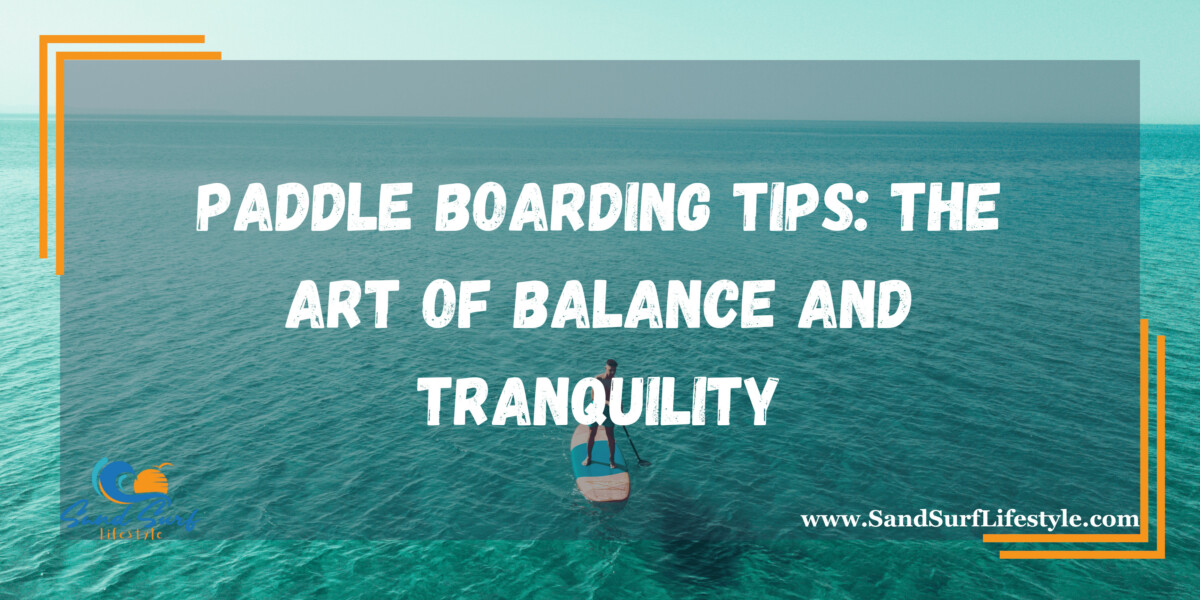Paddleboarding, with its unique blend of physical activity and serenity, has taken the water sports world by storm. Whether you’re gliding over the glassy surface of a tranquil lake, riding waves along the coast, or exploring winding rivers, paddleboarding offers a remarkable way to connect with nature while getting a full-body workout. But mastering the art of paddleboarding, like any sport, takes practice and knowledge.
Getting Started: Choosing the Right Board

Before you hit the water, you’ll need the right equipment. The first step is choosing the right paddle board. Factors like your skill level, intended use, and body type all play a role in this decision. For beginners, a wider, more stable board is recommended. These boards provide better balance, making them ideal for those who are just starting. As you gain experience and confidence, you can explore more specialized options, such as touring, racing, or surfing paddleboards.
To learn about a serene journey across calm waters while paddleboarding, check out this article.
Safety First: Essential Gear
Safety should always be a top priority when paddleboarding. The right gear can make all the difference, especially in unpredictable water conditions. Here’s a list of essential safety equipment to consider:
1. PFD (Personal Flotation Device)
A Coast Guard-approved PFD is a vital piece of equipment for any paddleboarder. While you may consider yourself a strong swimmer, unexpected situations can quickly arise on the water. Paddleboarding accidents, fatigue, or changing weather conditions can catch even experienced individuals off guard. A PFD provides an extra layer of safety by keeping you afloat in case you fall into the water. It’s not just a lifesaver; it’s your safety net, offering peace of mind and allowing you to focus on enjoying your paddleboarding adventure without the constant worry of staying afloat.
2. Paddle
Your paddle is your trusty companion on the water, and investing in a high-quality paddle is a game-changer. It’s not just about aesthetics; it’s about efficiency and comfort. When choosing a paddle, consider your height and paddle stroke style. A paddle that suits your physique and technique reduces fatigue, making your paddleboarding experience more enjoyable and less physically taxing. A well-designed paddle allows you to navigate with ease, maintain a steady pace, and minimize strain on your shoulders and arms, ensuring that your time on the water is as pleasant as possible.
3. Leash
Never underestimate the importance of a leash while paddleboarding, especially in choppy waters or areas with strong currents. This simple but essential accessory connects you to your board, preventing it from drifting away if you happen to fall off. In turbulent conditions or unexpected falls, your board can swiftly get carried away by the water, leaving you stranded and in potential danger. A leash not only keeps your board within reach but also allows you to quickly climb back onto it, maintaining your safety and control over the situation, making it a crucial tool for every paddleboarder’s safety arsenal.
4. Whistle
A whistle might seem like a small addition to your gear, but it serves as a valuable distress signal in times of need. Attach it to your PFD for easy access. In the event of an emergency or if you require assistance, a whistle can be a lifesaver. Its sharp, piercing sound carries over long distances, alerting others to your situation and need for help. While we hope you never find yourself in such circumstances, having a whistle on hand can be the difference between a swift rescue and a potentially perilous situation. It’s a small investment that packs a significant safety punch.
5. Sun Protection
Paddleboarding often involves spending extended periods under the sun’s intense rays, making sun protection essential. Remember to apply sunscreen generously to exposed skin to shield it from harmful UV radiation. Sunglasses with UV protection not only safeguard your eyes but also reduce glare, allowing you to see clearly on the water. Lastly, wearing a hat with a wide brim provides additional shade and protection for your face and neck. Prolonged sun exposure without adequate protection can lead to sunburn, skin damage, and eye strain, potentially diminishing the enjoyment of your paddleboarding experience. Prioritizing sun protection ensures that you can paddle comfortably and safely for longer periods.
Mastering the Basics: Stance and Balance
Now that you have the right equipment, it’s time to learn the fundamentals. Balance is at the heart of paddleboarding, and mastering it is essential for a safe and enjoyable experience.
1. The Right Stance
Achieving the right stance is fundamental to paddleboarding. Start in shallow water by your board’s side. Use your paddle horizontally across the board as support while you climb on. Once aboard, establish balance by positioning your feet shoulder-width apart, parallel to the stringer (the central line running lengthwise on the board). Ensure your toes point forward, knees are slightly bent, and maintain a straight back. This posture forms the foundation of stability and control, enabling you to confidently navigate various water conditions while maintaining a comfortable and balanced stance.
2. Finding Your Center
Maintaining balance on a paddleboard requires a keen sense of center. As you stand, consciously distribute your weight evenly between both feet. Engage your core muscles to aid in stabilizing your posture. This equilibrium between your feet and core is essential for stability, preventing wobbling or tipping. It allows you to adapt to shifts in the water’s surface, ensuring you remain upright and in control, even when paddling through waves or choppy waters.
3. Gaze Ahead
Where you direct your gaze plays a pivotal role in your paddleboarding experience. Keep your eyes fixed on the horizon rather than obsessively watching your feet. This technique not only enhances balance but also aids in navigation. By focusing on the horizon, you maintain a stable reference point. It helps you anticipate changes in the water’s surface and stay oriented, ensuring a smoother ride and reducing the chances of losing your balance.
4. Practice Paddling
Mastery of paddleboarding comes through practice, and a significant aspect of this practice involves getting accustomed to the sensation of movement on the board. Initiate your paddleboarding journey by performing short, gentle strokes on each side of the board. This gradual approach familiarizes you with the subtle adjustments required to maintain balance. Over time, you’ll develop muscle memory, allowing you to paddle with ease and confidence, even in varying water conditions.
5. Brace for Waves
When navigating water with small waves or chop, adapt your posture to absorb the impact effectively. Slightly bend your knees and utilize your leg muscles as shock absorbers. This technique enhances stability by allowing your body to move with the motion of the water. By keeping your knees flexed and using your legs as springs, you can ride through waves without losing balance. It’s a skill that becomes particularly valuable when exploring different bodies of water, where wave conditions can vary significantly.
Paddle Technique: Efficient and Effective Strokes

The paddling technique is crucial for efficiency and maneuverability on the water. Here are some tips to refine your paddle strokes:
1. Hand Placement
Proper hand placement on the paddle is crucial for efficient and effective strokes. Hold the paddle with one hand on the top, which is the handle, and the other on the shaft. Maintain a shoulder-width distance between your hands. This positioning allows for better control and leverage, enabling you to paddle with ease and precision.
2. Blade Angle
The angle of the paddle blade in the water significantly affects your paddling experience. To move smoothly through the water, keep the paddle blade angled slightly forward as you stroke. This forward angle minimizes resistance, allowing you to glide effortlessly. It’s a subtle adjustment that makes a noticeable difference in your ability to maintain a consistent and efficient pace.
3. Core Engagement
Paddleboarding isn’t just about arm strength; it’s about engaging your core muscles effectively. Power your strokes by driving force from your core rather than relying solely on your arm strength. With each stroke, engage your core muscles and rotate your torso. This rotational movement not only adds power to your strokes but also reduces strain on your arms, ensuring that you can paddle longer without fatigue.
4. Reach and Pull
To maximize the effectiveness of your strokes, practice reaching the paddle as far forward as comfortably possible before initiating the pull through the water. This extended reach allows you to cover more distance with each stroke. Focus on maintaining a fluid and continuous motion as you pull the paddle back. A smooth, unhurried rhythm ensures efficient propulsion and helps you maintain momentum.
5. Switch Sides
Maintaining a straight course on a paddleboard requires switching sides regularly. Paddle a few strokes on one side, then switch to the other. This balanced approach helps prevent drifting and maintains stability. It also distributes the workload evenly between both sides of your body, reducing the risk of overexertion on one side. Consistent side-switching is essential for straight-line tracking, especially in challenging conditions or when covering long distances.
6. Practice Makes Perfect
Like any skill, mastering paddleboarding techniques requires practice. Start in calm waters to refine your paddle technique before venturing into more challenging conditions. Spend time honing your strokes, experimenting with different angles and power levels, and becoming familiar with your board’s response to your movements. With consistent practice, you’ll build confidence in your abilities, allowing you to enjoy paddleboarding to the fullest, regardless of the water conditions you encounter.
Navigating Water Conditions: Wind, Waves, and Currents
Understanding and adapting to various water conditions is essential for safe and enjoyable paddleboarding. Here’s how to handle common challenges:
1. Wind
Paddling against the wind can be physically demanding and exhausting. To make your kayaking or canoeing adventure more enjoyable, start by heading into the wind when you set out. This strategy ensures that you’ll have the wind at your back when you return, making the journey back smoother and less strenuous. Beginners should be particularly cautious of strong winds, as they can make control difficult. Keeping an eye on wind forecasts is crucial for safety, allowing you to choose the right time and conditions for your paddling excursion.
2. Waves
Navigating through waves can be a thrilling part of kayaking or canoeing, but it requires skill and technique. Instead of approaching waves head-on, it’s wise to angle your craft slightly. This approach allows you to ride the waves more effectively, reducing the risk of capsizing and providing better stability. By mastering this technique, you can make wave-filled stretches of water more manageable and enjoy a safer and more exhilarating paddling experience.
3. Currents
Currents are dynamic and ever-present in many water bodies, and understanding them is crucial for paddlers. Always be aware of the direction and strength of currents in your area. Plan your route accordingly, considering how the current may impact your journey. When possible, use the current to your advantage, allowing it to assist in propelling your kayak or canoe. However, exercise caution, as strong currents can be challenging to navigate and may require advanced paddling skills.
4. Tides
Tides play a significant role in coastal paddling adventures. They can dramatically affect water depth and flow, making it essential to be well-informed about tide patterns. Familiarize yourself with tide charts specific to your location and plan your paddling trips accordingly. Understanding the tide schedule enables you to choose the optimal time to explore shallow areas or venture into tidal estuaries. By accounting for tides in your planning, you’ll ensure a safer and more enjoyable kayaking or canoeing experience while taking advantage of the ever-changing coastal environment.
Paddleboarding Etiquette: Sharing the Water
Paddleboarding etiquette is crucial for ensuring a positive experience for everyone on the water. Here are some important guidelines to follow:
1. Respect Others
When enjoying water activities like paddleboarding, it’s essential to practice respect for fellow water users. Whether there are swimmers, kayakers, or other paddleboarders nearby, always give them ample space. This not only ensures their safety but also contributes to a more pleasant and harmonious water experience. Avoid creating unnecessary wake or disturbances, and maintain a courteous and considerate attitude to foster a sense of community and safety on the water.
2. Right of Way
Understanding the right-of-way rules is crucial for preventing accidents and conflicts while paddleboarding. In most cases, individuals closer to the peak of a wave or the oncoming path should be given the right of way. It’s essential to yield to others to avoid collisions and maintain a safe environment. Being aware of your surroundings and respecting these principles ensures everyone can enjoy their time on the water without unnecessary disruptions or hazards.
3. Leave No Trace
Paddleboarders should embrace the “Leave No Trace” ethos, just like hikers and campers. Dispose of any trash or waste properly, ensuring it doesn’t end up in the water or on the shores. Additionally, take care not to disturb wildlife in the area. Observe animals from a respectful distance and avoid disturbing their habitats. By leaving the environment as you found it, you help preserve the natural beauty of waterways for future generations and protect the delicate ecosystems that depend on them.
4. Know the Rules
Before embarking on a paddleboarding adventure, make it a priority to familiarize yourself with local rules and regulations governing water activities. These rules can vary from one location to another, covering aspects like watercraft registration, speed limits, and specific paddleboarding guidelines. Knowing and adhering to these regulations not only keeps you in compliance with the law but also contributes to safety and responsible water recreation. It ensures a positive experience for everyone and minimizes the risk of accidents or legal issues while enjoying your time on the water.
Building Skills and Confidence: Practice and Progression

Like any sport, improving your paddleboarding skills takes time and dedication. Here are some tips to help you progress:
1. Consistent Practice
Regularly engaging in paddleboarding is key to improving your skills and overall experience. Consistent practice not only builds physical strength but also enhances your balance and confidence on the board. By spending time on the water regularly, you’ll become more attuned to the board’s movements and how to navigate various conditions. This increased comfort level allows you to enjoy paddleboarding to the fullest.
2. Take Lessons
For beginners, or even experienced paddleboarders looking to refine their techniques, taking lessons from a certified instructor is highly recommended. Instructors can offer invaluable guidance on proper paddling techniques, safety procedures, and equipment usage. Their expertise ensures you start on the right foot and can help prevent common mistakes that might lead to accidents.
3. Explore New Waters
Challenge yourself by exploring a variety of water bodies. From serene lakes to more challenging ocean waves, each environment offers unique experiences and tests your skills in different ways. This diversity not only keeps paddleboarding exciting but also helps you adapt to various conditions and become a more versatile paddler.
4. Join a Community
Connecting with local paddleboarding communities or clubs can enrich your experience. These groups often organize group outings, races, and social events, fostering a sense of camaraderie among fellow enthusiasts. Being part of a community can provide motivation, opportunities for skill sharing, and a chance to explore new waters with like-minded individuals.
5. Stay Informed
Paddleboarding is a dynamic sport with evolving trends, equipment, and safety practices. Staying informed about the latest developments is essential for continual skill enhancement. Follow industry news, attend workshops or seminars, and regularly review safety guidelines. By keeping up-to-date, you can make informed decisions about gear upgrades and adapt to new techniques or safety measures, ensuring that your paddleboarding experience remains safe and enjoyable.
To learn how to paddleboard, check out this article.
Conclusion
Paddleboarding is more than just a sport; it’s a lifestyle that allows you to commune with nature, stay active, and find tranquility on the water. By following these paddleboarding tips, you can embark on a journey that not only strengthens your body but also nourishes your soul. So, pick up your paddle, choose your board, and let the gentle rhythm of the water carry you toward a world of balance and serenity. Whether you’re a beginner or a seasoned paddler, there’s always more to explore and discover on the captivating journey of paddleboarding.
Please note that the contents of this blog are for informational and entertainment purposes only and should not be construed as legal advice. Any action taken based on the information provided in this blog is solely at your own risk. Additionally, all images used in this blog are generated under the CC0 license of Creative Commons, which means they are free to use for any purpose without attribution.

